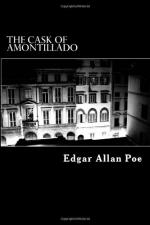|
This section contains 433 words (approx. 2 pages at 400 words per page) |

|
The Cask of Amontillado Summary & Study Guide Description
The Cask of Amontillado Summary & Study Guide includes comprehensive information and analysis to help you understand the book. This study guide contains the following sections:
This detailed literature summary also contains Bibliography on The Cask of Amontillado by Edgar Allan Poe.
"The Cask of Amontillado" was first published in the November 1846 issue of Godey's Lady's Book, a monthly magazine from Philadelphia that published poems and stories by some of the best American writers of the nineteenth century, including Nathaniel Hawthorne, Henry Wadsworth Longfellow, and Harriet Beecher Stowe. The story next appeared in the collection Poe's Works, edited by Rufus W. Griswold, Poe's literary executor, in 1850. By the time Poe wrote this story, he was already nationally known as the author of the poem "The Raven" (1844) and of several short stories collected in a book called, simply, Tales (1845). These earlier stories were widely reviewed and argued over by critics who found them brilliant and disturbing, and their author perplexing and immoral. Although "The Cask of Amontillado" was not singled out for critical attention when it appeared, it did nothing to change the opinions of Poe's contemporary admirers and detractors. Like Poe's other stories, it has remained in print continuously since 1850.
The story is narrated by Montresor, who carries a grudge against Fortunato for an offense that is never explained. Montresor leads a drunken Fortunato through a series of chambers beneath his palazzo with the promise of a taste of Amontillado, a wine that Montresor has just purchased. When the two men reach the last underground chamber, Montresor chains Fortunato to the wall, builds a new wall to seal him in, and leaves him to die. Several sources for the story have been suggested in the last century and a half: Edward Bulwer-Lytton's historical novel The Last Days of Pompeii (1843); a local Boston legend; a collection of Letters from Italy; and a real quarrel Poe had with two other poets. Wherever Poe got the idea and the impetus for "The Cask of Amontillado," this story and Poe's other short fiction had an undisputed influence on later fiction writers. In the nineteenth century, Poe influenced Ambrose Bierce and Robert Louis Stevenson, among others. Twentieth-century writers who have looked to Poe include science fiction writer H. P. Lovecraft and horror author Stephen King.
According to Vincent Buranelli, Poe's short stories also influenced the music of Claude Debussy, who was "haunted" by the atmosphere of Poe's tales, and the art of Aubrey Beardsley, as well as the work of other composers and artists in the United States, Great Britain, and in Europe. Poe was criticized in his own time for daring to examine a crime with no apparent motive, and a murderer with no apparent remorse. For one hundred and fifty years, these themes have continued to challenge readers, who are attracted and repulsed by Poe's creation.
Read more from the Study Guide
|
This section contains 433 words (approx. 2 pages at 400 words per page) |

|



